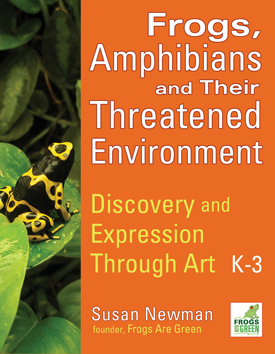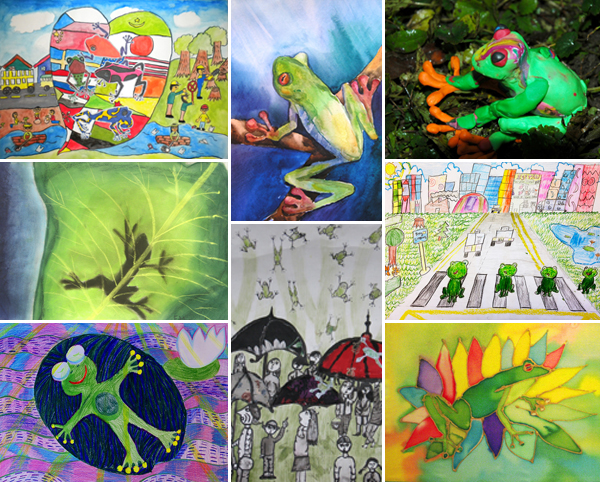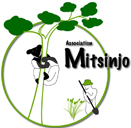Frogs, Amphibians, and Their Threatened Environment
Discovery and Expression Through Art – K-3
Chapter One – Introduction to Frogs and Amphibians.
>>Click here: Now Available for FREE download!
#1 on Amazon in “Environment Through Art”

164 Pages with more than 75 amazing photographs courtesy of Devin Edmonds, Kerry Kriger, David Veljacic, and Richard Bartlett and links to more than 12 videos.
by Susan Newman Lerer, founder of Frogs Are Green, Inc.
Endorsed by Amphibian Ark, Save the Frogs, Eco-Libris, Parc Mitsinjo, Sustainable JC, Mayor Steven Fulop and the City of Jersey City!
On Amazon:
>> Amphibian Education and Art Curriculum <<
In KINDLE format:
>> Amphibian Education and Art Teaching Resource <<
*Additional bonus pdf included on Claude Monet, prepared with commentary and imagery.
Claude Monet and the Gardens at Giverney – Art Discussion
** New Claude Monet website by Artsy!**
Their newly designed page includes his bio, over 60 high quality images of his works, exclusive articles written by their own editorial team, and up-to-date listings of current shows featuring his work – it’s definitely a unique resource for any information on Monet.
“Susan Newman’s new curriculum Frogs, Amphibians and Their Threatened Environment: Discovery and Expression through Art, K-3 (including many beautiful photos of frogs) provides a new way for children to learn about amphibians and express appreciation of this ‘living art’ through their own artistic work. This curriculum addresses the need for biology and art to not always be taught as separate subjects. This interdisciplinary approach may foster greater understanding of biological concepts and the opportunity to develop a more personal meaning with the natural world through observation and interpretation.”
— Rachel Rommel, Community Education Officer, Amphibian Ark
“Susan has designed a course about amphibians that combines both creativity and science, providing an opportunity where the traditional school classroom doesn’t have to stick to the single boring plan but can bridge several subjects to generate interest in and knowledge about nature through artwork. The designed program is fun, informative, and factual, allowing students to express themselves creatively with amphibians on the mind.”
— Devin Edmonds, Amphibian Conservation Director, Association Mitsinjo
“Frogs, Amphibians, and Their Threatened Environment is obviously a labour of love. The lesson plans are well thought out to involve a child’s natural creativity and curiosity, giving them a stronger connection to the topic. Frogs are popular animals with children and with these lesson plans the kids can easily be kept interested, involved, and learning about the important role amphibians play in our environment.”
— David Veljacic, Nature Lover
Common Core Curriculum with room for art and creativity
“As an educator of 15+ years, I know that it can get difficult to fit art and creativity in to the curriculum in today’s educational landscape.
Susan Newman has taken her passion for art, environmental conservation, and teaching and combined them into a fantastically cohesive, easily taught series of 6 lesson plans. Each is meant to be taught once a week, in about 45 minutes, though they could easily be compressed into a shorter spread of time. The Author has provided a clear and easy to follow outline, materials needed are listed for each lesson, and the Common Core Standards are laid out, making it easy to justify the subject matter and the art projects, even for the most stringent districts.”
— Renee Barrett, Educator and book designer
It’s a well written, well aligned unit that can offer a way to get students thinking about the environment and art effectively and in a unique way.
 Summary: Children in K-3 are introduced to frogs, amphibians and the world that surrounds them. By learning about the Earth’s environment and wildlife and having an understanding of the eco-system, they can creatively express themselves through art and share with others how everyone can help the earth by being eco-friendly. Students will be introduced to photographers and artists, both classical and current, who focus on nature and wildlife.
Summary: Children in K-3 are introduced to frogs, amphibians and the world that surrounds them. By learning about the Earth’s environment and wildlife and having an understanding of the eco-system, they can creatively express themselves through art and share with others how everyone can help the earth by being eco-friendly. Students will be introduced to photographers and artists, both classical and current, who focus on nature and wildlife.
Week One: Introduction to Frogs and Amphibians
What are frogs and amphibians?Focus is on variety – common vs. most unusual. (Photography, video display and discussion.)
**Art project: select a particular frog and create a portrait using colored pencils, crayons or pastels.
Week Two: The Food Chain
What do frogs eat, and what eats frogs? How do they defend themselves? Poisonous skin, camouflage. (Photography, video display and discussion.)
**Art project: Create artwork of frogs/amphibians interacting with other wildlife using paint, either watercolor or gauche.
Week Three: Frog Friendly Habitats
Where do they live? Marshlands, deserts, forests and rainforests.Discussion (bonus art project) of master painter Claude Monet. (Photography, Monet paintings and discussion.)
**Art project: Create artwork like Monet with lily pads and frogs using either colored pencils, crayons, pastels or paint.
Week Four: Biodiversity in the Rainforest
Rainforests produce and protect biodiversity. Children picture themselves as a frog inside the rainforest and discuss what they see, smell, taste, hear, sense. (Display of rainforest imagery, video and discussion.)
**Art project: Create a 3d frog or amphibian (materials to be determined, clay, play-doh, paper, foliage, etc.)
Week Five: Reproduction & Care of Young
Where and how do frogs lay their eggs? On leaves, in flowers, pools, ponds, and some males carry eggs on their back. Who watches the eggs, the male or female? (Display of imagery, video and perhaps select an artist who specializes in *recycled* artwork for display and discussion.)
**Art project: Create a frog friendly environmental picture showing eggs, tadpoles, and frogs. (Materials to be determined, collage/mixed medium.)
Week Six: Threats to Survival
What are the threats frogs and amphibians face Cars on roads where they migrate; deforestation that destroys their habitat; chytrid fungus; climate change and how it affects rainforests and lakes; ponds drying up; pesticides used in farming that run off into streams, lakes and ponds. What can we do to help them survive? (*Photography, video display and discussion.)
**Art project: Create an awareness art piece with words and imagery about a healthy planet.
Visual Arts
Content Standard – K-4 Visual Arts Standard 1-3
Understanding and Applying Media, Techniques and Processes
Achievement Standard
- Students know the differences between materials, techniques, and processes
- Students describe how different materials, techniques, and processes cause different responses
- Students use different media, techniques, and processes to communicate ideas, experiences, and stories
- Students use art materials and tools in a safe and responsible manner
- Students know the differences among visual characteristics and purposes of art in order to convey ideas
- Students explore and understand prospective content for works of art
- Students select and use subject matter, symbols, and ideas to communicate meaning
Science
Standard 6
Understands relationships among organisms and their physical environment
Content Standard: Life Science:The characteristics of organisms
- Organisms have basic needs; the behavior of individual organisms is influenced by internal cues and external cues.
Content Standard: Life Science: The lifecycles of organisms
- Plants and animals have life cycles that include being born, developing into adults, reproducing and eventually dying. Many characteristics of an organism are inherited from the parents of the organism, but other characteristics result from an individual’s interaction with the environment.
Learning Objectives
Students will:
- Learn about frogs and amphibians, and the environment and wildlife around them
- Express themselves using different mediums each week, creating artwork. Learning more about color palettes, materials, and the visual arts.
- Learn about some famous painters and photographers who specifically created works about nature and wildlife. (Full Artist and Photographers list to come.)
- Learn about rain forests and large parks and where they are located
- Learn about endangered amphibians and what that means
- Learn what sustainability and conservation is and how it can make a difference
Teaching Approach
Arts integration through scientific education
Teaching Methods
- Show photography and artworks created by classical artists, current artists, and international children’s works
- Experiential Learning
- Role Playing
Preparation
Lesson Setup
Lessons will require the following materials:
- Photo display of frogs and amphibians from the most common to the most unusual
- Photo display of bugs, dragonflies, as well as snakes, to show the food chain
- Photo and/or video of a frog’s tongue catching a bug to show speed and accuracy
- Photos and/or artwork of frogs, amphibians, rainforests, biodiversity of species (amphibians, birds, reptiles, insects…) in rainforests, forests, marshlands, ponds, deserts
- Photos of where frogs lay eggs, on leaves, in pools, ponds, etc.
- Photos that describe the threats to frogs and amphibians such as: cars/roads where they migrate; deforestation where their home used to be; chytrid fungus and what scientists are doing; climate change and how that affects the rain forests and lakes, ponds; ponds that are drying up; pesticides for farming which go into the streams, lakes and ponds.
*Collect specific artists and photographer’s artwork to showcase what has been created as you assign each week’s art project.
Endorsed by Amphibian Ark, Save the Frogs, Eco-Libris, Parc Mitsinjo, Sustainable JC, Mayor Steven Fulop and the City of Jersey City!










Pingback: New Project Fundraiser On SJC’s ioby Platform – Go ‘FROGS ARE GREEN’ ! | Sustainable JC
Pingback: How To Teach Your Kids About Climate Change | Frogs Are Green